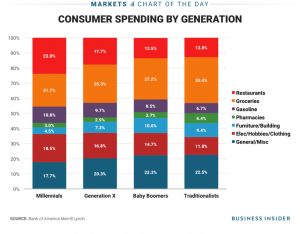
Think fast: you have an extra $100 to splurge. How will you spend it? These days, more and more people are choosing to buy experiences such performances or concerts, travel, painting, pottery classes, or yoga sessions instead of tangible items. Shoe lovers may not agree, but experts believe this form of expenditure leads to more overall happiness.
Buying Memories
Millennials, America’s largest generation by population, are the driving force of our economy. They currently generate about $1.3 trillion in annual consumer spending. When it comes to money, 78% say experience purchases trump ‘things”, according to a poll conducted by the HARRIS Group on behalf of Eventbrite. Look around your neighborhood, and it is obvious that retail business is on the decline. Brick and mortar stores are shutting down while consumers turn to online shopping as a way to save both money and time. But it’s more than that. People are just buying less stuff these days, and it’s not just shoes and handbags.
According to the same poll, consumer analysts observed a drop in big ticket items like home and car ownership. Buying a home and purchasing your first car used to be rites of passages, but this generation sees it as a waste of money, preferring to rent or lease instead. This dynamic is predicted to increase: 72% say they would like to increase their spending on experiences, which they believe help shape their identity, create life-long memories and connects them to other people, the community and the word.
This tend isn’t limited to young people, according to Dr. Thomas Gilovich, a professor at Cornell University who has been conducting a 20-year study on how people choose to allocate their money. He says that there is a common misconception that possessions will generate satisfaction, but this is not the case. The Easterlin Paradox is a theory in economics named after economist Richard Easterlin, which claims that citizens’ overall life satisfaction doesn’t match their country’s gross domestic product (GDP). In other words, contrary to popular belief, you are not going to be happier if you earn more income. The understanding behind this phenomenon is that because all of our basic needs have already been met while living in a civilized society (food, shelter, and clothes) acquiring more money will not grant us long-lasting happiness. “One of the enemies of happiness is adaptation,” explains Dr. Gilovich. “We buy things to make us happy, and we succeed. But only for a while since new things are exciting to us at first, but then we adapt to them.”
When we buy a new outfit, car, or home we initially feel exhilarated. We might feel that we can excel at work with our new attire, confront the world while we zoom around in our new car, and find peace in our stainless steel, streamlined kitchen, but fast forward a couple of weeks and the allure wears off. Suddenly, that power suit is designated to the back of the closest, the vehicle loses its new car smell, and the house is just another house. When we invest in experiences, we form everlasting memories that can be mentally retrieved when we need a pick-me-up. Memories never lose their luster. “Any well-planned powerful experience from a haunted house to 3-day immersion retreat results in a dopamine rush, which causes feelings of euphoria,” explains Marc Cordon, a positive psychology coach with a background in neuroscience and behavior.
Jewish Viewpoint
This is not a new concept for Jews. The Torah has always warned against spending money on frivolous items and investing instead in the experience of doing mitzvos. One place we see evidence of this lesson is when Hilell HaGadol preached, “The more flesh the more worms; the more possessions the more worry.” (Pirkei Avos 2.8). In Koheles it is written, “Hevel havalim hakol hevel,” which translates to materialism (vanity) is nothing, it is all nothingness (1:2-4). The one time the Torah does allow and encourage us to overspend is when we are engaging in a mitzvah, or in the preparation of Shabbos or Yom Tov. There are many stories in Jewish folklore of simple folks with modest means who spent all their money on the perfect, blemish free esrog. There are those that spend thousands to acquire the nicest and biggest menorah to adorn their windowsill as a way to publicize the miracle of Chanukah, or a sterling silver kiddush cup to accessorize the Shabbos table. They do this because they feel that by investing in the ritual item, the experience of the mitzvah gets enhanced. Jews donate money to synagogues well beyond their required membership dues as a way to feel like they are part of something larger than themselves. This kind of spending provides people “a sense of belonging through membership, a feeling of influence, and a shared powerful experience, “says Marc Cordon.
I have observed a phenomenon that seems to be spreading within the Orthodox circles: Israel bar mitzvahs. This has been a custom mostly done by Reform and Conservative Jews, but today more and more Orthodox families are opting to hold their sons’ bar mitzvah ceremonies at the Kosel followed by a few days of touring holy sites rather than spend money on invitations, a fancy hall, musicians, and florists. The idea behind this is that the family can spend several amazing days together bonding over this momentous occasion as they tour historic parts of Yerushalayim and visit famous Rabbis. No party can match the experience of putting on tefillin at the Kosel; this is a moment the boy and family will cherish forever. Bruce Altchouler, who owns and runs Israel Travel Secrets, a family tour guide company, has seen a huge increase in the number of people choosing to celebrate their bar/bas mitzvahs in Israel since there is a certain atmosphere when you visit the holy sites with their rich history and symbolism that cannot be replicated anywhere but the Jewish homeland. Altchouler says this trend has become more popular as it has become more mainstream adding, “When I was at that age, some 40 years ago, it was a very uncommon almost unheard of option, but now people are beginning to see that the standard party with a DJ has become somewhat tired. For the same monetary investment, you can bring your family to Israel.”
Chaim and Rivky Spira of Marine Park recently celebrated their son’s bar mitzvah and chose to do it in Israel (in addition to a hall party) and they say it was the best decision they ever made. “As a mom standing in the ladies section peering over the michitza, watching my husband help my son wind up the tefillin and place it on his head, I was very emotional,” she says. “What better place to pray for our son’s wellbeing and future than at the Kosel?” she rhetorically asks.
Why not experience something different? A bar mitzvah in Israel is an experience for the whole family, not just the bar mitzvah boy.
Footing the Facebook Bill
You may not realize it, but every time you login or post to Facebook or Instagram, you are changing the trajectory of the economy. Twitter, Snapchat, Instagram and Facebook are all digital culprits that can be blamed for this marketing shift that has majorly impacted the economy in the last decade. People tune into social media sites numerous times a day to see what their friends are doing and to post and share what is going on in their lives. Millennials are notorious for having this fear of FOMO, a 2004 acronym for fear of missing out, and social media assures that they are always plugged in.
When Professor Alexander S. Lowry isn’t teaching finance at Gordon College, he works as an advisor mentoring CEOs and boards who want to turn strategy into action. He admits that consumers are spending less on nonessential goods than they did 15 years ago. He attributes this to the rise of the millennials. “Think about where these young consumers go all day. They consume social media sites like Facebook,” he says. Thus, much of what consumers are looking for is driven by pressure created by social media. Thanks to social media platforms, “customers can instantaneously share their trips through pictures, videos and gifs. There is a drive to compete with family members and friends. Consumers no longer want mementos and souvenirs; instead it’s experiences they are looking for,” he says.
The Future of Spending
So is it better to spend that $100 on new watch or to take your family out on a skating excursion? The watch can be displayed on your wrist for months until you tire of it or it breaks, but who knows how long the kids will fondly remember your double axel spin? Money, no matter how you choose to spend It is fleeting. America is a consumer-focused society. We spend more than we earn. “That’s troubling! And I don’t see it getting any better,” warns Professor Lowry, who worries that we will just continue on this path of senseless spending. Lowry points out that during the financial crisis people actually reduced debt, but since the recovery, “we’re returned to our old (bad) habits.”
There are certain basic objects we all require: a home, car, clothes and food, but next time you open your wallet, ask yourself if that that legal tender could be used in a more productive manner which enriches your life, not just your possessions. Or better yet, ask yourself if you even need to spend money to accomplish this goal. I suppose the takeaway lesson here is that you don’t need to spend money on materialistic items to gain happiness. Then again, you also shouldn’t have to shell out money to manufacture a memory. True bliss as Pirkei Avos taught us long ago, is someone who is happy with his lot.

Rise of Escape Rooms
Talk about paying for an experience: escape rooms are popping up everywhere! They are a physical adventure game in which players (usually groups of 4-8 people) are given a set time limit to decode clues and solve puzzles and riddles in order to escape a locked, windowless room. There is even a Jewish escape room right here in Midwood equipped with a King David Room and Rashi Room. Being trapped in a claustrophobic room and having to pay $25-30 to get out may not sound like fun, but obviously many think it is. As of 2017, escape rooms have boomed to about 2,000 rooms across the U.S. What is the appeal, you ask? Well, besides for giving you a unique format of spending quality time with friends and family, they also offer participants a chance to test their analytical thinking and puzzle-solving skills. Factor in the adrenaline rush, which is fueled by a faux-high-stakes game concluding with a photo-op finish, and it is no wonder why escape rooms have become American’s newest, favorite pastime.

You Have to Pay for That?
Here is a list of acts that we today pay good money for while our grandparents would shake their heads and ask: They’re not paying you, but you are paying them?
Rock climbing: We pay to be holstered to a safety belt, so we can climb a wall while grabbing onto mounted, multicolored rocks and cones as we hold on for dear life as we sweat and struggle to reach the top of an artificial mountain.
Pumpkin or fruit picking: Get charged admission to walk through a pumpkin patch or farmer’s field and schlep 10 pound pumpkins or climb ladders to fill baskets of apples from trees, which you will then have to weigh and pay to take home.
Cook: No longer a common daily domestic chore, now you can be charged to sit through a tutorial on how to prepare a meal and then be expected to pay to cook and eat what you’ve just made whether it comes out good or bad.
Paint: It used to be you commissioned a professional artist to paint a specific picture of your liking so you can then use it to adorn your walls, but now the tables have been turned. The painter is telling you how and what to paint, and YOU are paying them for the guidance.
Dig Dirt: There are actually places (like Diggerland) where you have to pay money to haul dirt and debris while operating a bulldozer.
You must be logged in to post a comment.